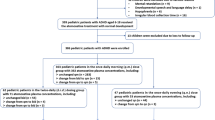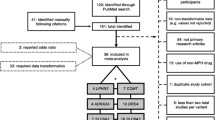Abstract
Objective
Although several genes have previously been studied about the treatment of Attention Deficit Hyperactivity Disorder (ADHD), the number of studies investigating the effects of genes on atomoxetine (ATX) treatment is very limited. In this study, we aimed to investigate the effect of CYP2C19 polymorphisms, which have a role in ATX biotransformation, on the treatment response and also to assess whether there is a relationship between BDNF and treatment response in children and adolescents with ADHD.
Methods
One hundred children with ADHD and 100 healthy controls (HCs) were included in this study. The treatment response was assessed 2 months after the start of the ATX treatment. DNA samples from peripheral venous blood were replicated using PCR and analyzed using the ILLUMINA next-generation sequencing method. The resulting fastqs were analyzed using Basespace’s Variant Interpreter Program. Plasma BDNF levels were evaluated with ELISA kits.
Results
Treatment response was found to be lower in both heterozygous and homozygous carriers of the c.681G > A (CYP2C19*2) polymorphism. When the BDNF level was compared, it was found to be significantly higher in the ADHD group compared to HCs. Also, BDNF has a stronger predictive value for assessing resistance to ATX treatment.
Conclusions
To our knowledge, this is the first study to assess the effects of CYP2C19 polymorphisms and BDNF levels together on ATX treatment in children. Further studies with an extensive population are needed to better understand the effects of CYP2C19 polymorphisms on treatment and side effects, as well as the effects of BDNF levels.


Similar content being viewed by others
References
Am Psychiatric Assoc, American Psychiatric Association & American Psychiatric Association (2013) Diagnostic and statistical manual of mental disorders: DSM-5. Arlington, VA
Biederman J, Spencer TJ (2008) Psychopharmacological interventions. Child Adolesc Psychiatr Clin N Am 17(2):439–458
Zhou J (2004) Norepinephrine transporter inhibitors and their therapeutic potential. Drugs of the Future 29:1235–1244
Newcorn JH, Kratochvil JC, Allen JA et al (2008) Atomoxetine and osmotically released methylphenidate for the treatment of attention deficit hyperactivity disorder: acute comparison and differential response. Am J Psychiatry 165(6):721–730
Kooij SJ, Bejerot S, Blackwell A et al (2010) European consensus statement on diagnosis and treatment of adult ADHD: the European Network Adult ADHD. BMC Psychiatry 10(1):1–24
Greenhill LL, Newcorn JH, Gao H, Feldman PD (2007) Effect of two different methods of initiating atomoxetine on the adverse event profile of atomoxetine. J Am Acad Child Adolesc Psychiatry 46(5):566–572
Belpaire FM, Bogaert MG (1996) Cytochrome P450: genetic polymorphism and drug interactions. Acta Clin Belg 51(4):254–260
Ring BJ, Gillespie JS, Eckstein JA, Wrighton SA (2002) Identification of the human cytochromes P450 responsible for atomoxetine metabolism. Drug Metab Dispos 30(3):319–323
Gumus E, Karaca O, Babaoglu MO et al (2012) Evaluation of lansoprazole as a probe for assessing cytochrome P450 2C19 activity and genotype-phenotype correlation in childhood. Eur J Clin Pharmacol 68(5):629–636
Zhou SF (2009) Polymorphism of human cytochrome P450 2D6 and ıts clinical significance. Clin Pharmacokinet 48(12):761–804
Choi CI, Bae JW, Lee YJ, Lee HI, Jang CG, Lee SY (2014) Effects of CYP2C19 genetic polymorphisms on atomoxetine pharmacokinetics. J Clin Psychopharmacol 34(1):139–142
Ter Laak MA, Temmink AH, Koeken A, Van ’T Veer NE, Van Hattum PRM, Cobbaert CM (2010) Recognition of impaired atomoxetine metabolism because of low CYP2D6 Activity. Pediatr Neurol 43(3):159–162
Hassan D, Ali H, Abdo Mohammed S, Amr KS, Abdel-Malik M, Rabie M (2018) Genetic polymorphisms and therapeutic response to atomoxetine in Egyptian children with Attention-deficit Hyperactivity Disorder. AZJP 21(1):1970–1989
Ramos-Quiroga JA, Corominas-Roso M, Palomar G et al (2014) Changes in the serum levels of a brain-derived neurotrophic factor in adults with attention deficit hyperactivity disorder after treatment with atomoxetine. Psychopharmacol 231(7):1389–1395
Fumagalli F, Cattaneo A, Caffino L et al (2010) Sub-chronic exposure to atomoxetine up-regulates BDNF expression and signaling in the brain of adolescent spontaneously hypertensive rats: comparison with methylphenidate. Pharmacol Res 62(6):523–529
Jukić MM, Opel N, Ström J et al (2017) Elevated CYP2C19 expression is associated with depressive symptoms and hippocampal homeostasis impairment. Mol Psychiatry 22(8):1224
Unal F, Oktem F, Cetin Cuhadaroclu F et al (2019) Reliability and validity of the schedule for affective disorders and schizophrenia for school-age children-present and lifetime version, DSM-5 November 2016-Turkish adaptation (K-SADS-PL-DSM-5-T). Turk Psikiyatri Derg 30:42–50
Kaner S, Buyukozturk S, Iseri E (2013) Conners parent rating scale-revised short: Turkish standardization study/Conners anababa dereceleme olcegi-yenilenmis kisa: Turkiye stardardizasyon calismasi. Arch Neuropsychiatry 50(2):100–110
Guy W (1976) ECDEU Assessment manual for psychopharmacology: US Department of Health, Education, and Welfare Public Health Service Alcohol, Drug Abuse, and Mental Health Administration. Natl Inst Ment Heal Psychopharmacol Res Branch, Div Extramur Res Programs
Barkley RA, McMurray MB, Edelbrock CS, Robbins K (1990) Side effects of methylphenidate in children with attention deficit hyperactivity disorder: a systemic, placebo-controlled evaluation. Pediatrics 86(2):184–192
Aman MG, Smith T, Arnold LE et al (2014) A review of atomoxetine effects in young people with developmental disabilities. Res Dev Disabil 35(6):1412–1424
McDonagh MS, Peterson K, Thakurta S, Low A (2012) Drug class review: pharmacologic treatments for attention deficit hyperactivity disorder: final update 4 reports
Ring BJ, Gillespie JS, Eckstein JA, Wrighton SA (2002) Identification of the human cytochromes P450 responsible for atomoxetine metabolism. Drug Metab Dispos 30:319–323
Scott SA, Martis S, Peter I, Kasai Y, Kornreich R, Desnick RJ (2012) Identification of CYP2C19∗4B: pharmacogenetic implications for drug metabolism including clopidogrel responsiveness. Pharmacogenom J 12:297–305
Skierka JM, Black JL III (2014) Analysis of compound heterozygous CYP2C19 genotypes to determine cis and trans configurations. Pharmacogenomics 15:1197–1205
Aynacioglu AS, Sachse C, Bozkurt A et al (1999) Low frequency of defective alleles of cytochrome P450 enzymes 2C19 and 2D6 in the Turkish population. Clin Pharmacol Ther 66(2):185–192
Trzaska KA, King CC, Li KY et al (2009) Brain-derived neurotrophic factor facilitates maturation of mesenchymal stem cell-derived dopamine progenitors to functional neurons. J Neurochem 110(3):1058–1069
Pezawas L, Verchinski BA, Mattay VS et al (2004) The brain-derived neurotrophic factor val66met polymorphism and variation in human cortical morphology. J Neurosci 24(45):10099–10102
Corominas-Roso M, Ramos-Quiroga JA, Ribases M et al (2013) Decreased serum levels of brain-derived neurotrophic factor in adults with attention deficit-hyperactivity disorder. Int J Neuropsycho Pharmacol 16(6):1267–1275
Spaldıng KL, Bergmann O, Alkass K et al (2013) Dynamics of hippocampal neurogenesis in adult humans. Cell 153(6):1219–1227
Banerjee PS, Aston J, Khundakar AA, Zetterstrom TS (2009) Differential regulation of psychostimulant-induced gene expression of brain-derived neurotrophic factor and the immediate-early gene Arc in the juvenile and adult brain. Eur J Neurosci 29(3):465–476
Sun H, Cocker PJ, Zeeb FD, Winstanley CA (2012) Chronic atomoxetine treatment during adolescence decreases impulsive choice, but not impulsive action, in adult rats and alters markers of synaptic plasticity in the orbitofrontal cortex. Psychopharmacol 219(2):285–301
Younan MR, Said SZ, Abd Alkarim SM, Abd Alwahab WM (2019) Effect of treatment by atomoxetine on the serum level of brain-derived neurotrophic factor in children with attention deficit hyperactivity disorder. MJMR 30:317–323
Stingl JC, Scholl C, Bosch JE, Viviani R (2021) Genetic polymorphism of CYP2C19 and subcortical variability in the human adult brain. Transl Psychiatry 11(1):1–5
Numakawa T, Yokomaku D, Richards M, Hori H, Adachi N, Kunugi H (2010) Functional interactions between steroid hormones and neurotrophin BDNF. World J Biol Chem 1(5):133–143
Funding
This study was supported by the Scientific Research Center of Erciyes University (Grant number TOA-2018–7800). The Scientific Research Center of Erciyes University had no role in study design; in the collection, analysis, and interpretation of data; and in the writing of the report.
Author information
Authors and Affiliations
Contributions
Designed the study: ED and EFS. Performed the experiments or case: ED and MKG. Analyses of gene variants: FD, EFS, and MGO. Analyzed the data: ED, MKG, EFS, and MGO. Wrote the paper: ED and EFS. All authors have read and approved the final manuscript.
Corresponding author
Ethics declarations
Conflict of interest
The authors declare no competing interests.
Additional information
Publisher's Note
Springer Nature remains neutral with regard to jurisdictional claims in published maps and institutional affiliations.
This study was conducted between 2017 and 2019. Preliminary data of the study has been presented as a verbal presentation in May 2021 at the 30th National Child and Adolescent Psychiatry Congress in Turkey and is not currently under consideration for publication in another journal.
Supplementary information
Below is the link to the electronic supplementary material.
Rights and permissions
About this article
Cite this article
Demirci, E., Sener, E.F., Gul, M.K. et al. A view of response and resistance to atomoxetine treatment in children with ADHD: effects of CYP2C19 polymorphisms and BDNF levels. Eur J Clin Pharmacol 78, 1095–1104 (2022). https://doi.org/10.1007/s00228-022-03321-2
Received:
Accepted:
Published:
Issue Date:
DOI: https://doi.org/10.1007/s00228-022-03321-2




